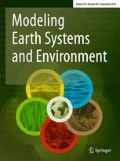Abstract
Pond roof system is one of the best ways to save energy. This article has been done to evaluate the thermal behavior of the pond roof in optimizing the energy consumption of residential buildings in Yazd with hot and dry climate and also compared the results of other studies on the proper height of the water layer on the pond roof and its comparison with green roof. The research method is quantitative, and library and documentary studies have been used to complete the literature. This study was aimed at investigating the effect of factors affecting the thermal performance of roof pond systems, such as water height on the annual energy consumption, and evaluating the sustainability and efficiency of using roof pond systems in the hot and dry climate of Yazd City. Design Builder software is the energy simulator program used in this study. First, using energy simulator software (Design Builder), the effect of green roof with different bed layers and pond roof with different water heights on the annual energy consumption of a residential building in Yazd w investigated. It also calculates the cooling and heating load based on the ASHRAE standard using the heat balance used in Energy Plus. The results show that with increasing water layer height, the building better performance in energy efficiency. Evaluating the height of the water layer 5–15–25–35–45–55–65 cm respectively 7.77%, 8.11%, 8.54%, 8.91%, 9.15%, 9.53%, 9.86% in annual energy consumption in the simulated residential sample has been saved and also compared to conventional roof has about 86% less heat transfer and compared to green roof about 11 times in optimizing annual heating energy and about 1.4 times in optimizing annual cooling energy and about. It has 1.8 times better thermal performance in annual energy consumption, and by examining the amount of water consumption for storage with gray water regeneration and also the optimal thermal performance of the closed roof pond with fixed insulation cover, the appropriate height of the pond was determined to be about 30 cm.




















Similar content being viewed by others
References
Abdulla FA, Al-Shareef AW (2009) Roof rainwater harvesting systems for household water supply in Jordan. Desalination 243(1–3):195–207
Alvarez S, Molina JL. Santamouris M (2003) Cooling by natural sinks (pp. 140–162). London, pp: James & James
Bravo G, González E (2013) Thermal comfort in naturally ventilated spaces and under indirect evaporative passive cooling conditions in hot–humid climate. Energy Build 63:79–86
Cheshmidari MN, Hatefi Ardakani AH, Alipor H, Shojaei S (2017) Applying Delphi method in prioritizing intensity of flooding in Ivar watershed in Iran. Spat Inf Res 25(2):173–179
Dehghani AA, Bahremand AR, Shojaei S (2017) Intelligent estimation of flood hydrographs using an adaptive neuro–fuzzy inference system (ANFIS). Model Earth Syst Environ 3(1):1–9
Duan Z, Kang J, Li J, Zhao X (2022) Simulation for the thermal performance of super-hydrophilic fabric evaporative cooling roof based on experimental results. J Build Eng 52:104377
Ebadati M, Ehyaei MA (2020) Reduction of energy consumption in residential buildings with green roofs in three different climates of Iran. Adv Build Energy Res 14(1):66–93
Farzi A, Mehrabadi J (2019) Systematic Analysis of Strengths, Weaknesses, Opportunities and Threats of On-site Greywater Reuse in Iran Based on Fuzzy Analytical Hierarchy Process. Iran Water Resour Res 15(4):328–339
Ferdyn-Grygierek J, Grygierek K, Gumińska A, Krawiec P, Oćwieja A, Poloczek R, Żukowska-Tejsen D (2021) Passive cooling solutions to improve thermal comfort in polish dwellings. Energies 14(12):3648
Filippın C (2000) Benchmarking the energy efficiency and greenhouse gases emissions of school buildings in central Argentina. Build Environ 35(5):407–414
Ghalenoei E, Dettmer J, Ali MY, Kim JW (2021) Gravity and magnetic joint inversion for basement and salt structures with the reversible-jump algorithm. Geophys J Int 227(2):746–758
Hamidy N, Alipur H, Nasab SNH, Yazdani A, Shojaei S (2016) Spatial evaluation of appropriate areas to collect runoff using Analytic Hierarchy Process (AHP) and Geographical Information System (GIS) (case study: the catchment “Kasef” in Bardaskan. Model Earth Syst Environ 2(4):1–11
Jain D (2006) Modeling of solar passive techniques for roof cooling in arid regions. Build Environ 41(3):277–287
Jain N, Burman E, Stamp S, Shrubsole C, Bunn R, Oberman T, Davies M (2021) Building performance evaluation of a new hospital building in the UK: Balancing indoor environmental quality and energy performance. Atmosphere 12(1):115
Kadaverugu A, Kadaverugu R, Chintala NR, Gorthi KV (2021) Flood vulnerability assessment of urban micro-watersheds using multi-criteria decision making and InVEST model: a case of Hyderabad City, India. Model Earth Syst Environm 1:1–13
Kasprzyk-Hordern B, Dinsdale RM, Guwy AJ (2009) Illicit drugs and pharmaceuticals in the environment–Forensic applications of environmental data. Part 1: Estimation of the usage of drugs in local communities. Environm Pollut 157(6):1773–1777
Kharrufa SN, Noori F (2022) A review of thermal design for buildings in hot climates. Pertanika J Sci Technol 30(1):813–839
Krivtsov V, Birkinshaw S, Yahr R, Olive V (2021) Comparative ecosystem analysis of urban ponds: implications for synergistic benefits and potential trade-offs resulting from retrofitting of green roofs in their catchments. Int J Environm Impacts 4(4):323–339
La Roche P, Berardi U (2014) Comfort and energy savings with active green roofs. Energy Build 82:492–504
La Roche P (2018) Passive cooling systems in times of climate change. In Activism in Architecture (pp. 93–107). Routledge
Madhurab KR (2022) Analysis of Thermal Performance, Efficiency, and Effectiveness of a Straight Porous Fin with Variable Thermal Conductivity. J Eng Phys Thermophys 95(2):392–401
Moosavi R, Vakilinezhhad R (2021) Experimental evaluation of summer thermal comfort in various types of Sardab (Cellar): underground space in Iran vernacular houses. J Heat Mass Transfer Res 8(1):1–11
Morales-Pinzón T, Lurueña R, Rieradevall J, Gasol CM, Gabarrell X (2012) Financial feasibility and environmental analysis of potential rainwater harvesting systems: A case study in Spain. Resour Conserv Recycl 69:130–140
Mun JS, Han MY (2012) Design and operational parameters of a rooftop rainwater harvesting system: definition, sensitivity and verification. J Environ Manage 93(1):147–153
Mushtaha E, Salameh T, Kharrufa S, Mori T, Aldawoud A, Hamad R, Nemer T (2021) The impact of passive design strategies on cooling loads of buildings in temperate climate. Case Stud Thermal Eng 28:101588
Okoye CO, Solyalı O, Akıntuğ B (2015) Optimal sizing of storage tanks in domestic rainwater harvesting systems: A linear programming approach. Resour Conserv Recycl 104:131–140
Pearlmutter D, Berliner P (2017) Experiments with a ‘psychrometric’roof pond system for passive cooling in hot-arid regions. Energy Build 144:295–302
Piri I, Khanamani A, Shojaei S, Fathizad H (2017) Determination of the best geostatistical method for climatic zoning in Iran. Appl Ecol Environ Res 15(1):93–103
Pourabadeh A, Baharinikoo L, Shojaei S, Mehdizadeh B, Davoodabadi Farahani M, Shojaei S (2020) Experimental design and modelling of removal of dyes using nano-zero-valent iron: a simultaneous model. Int J Environ Anal Chem 100(15):1707–1719
Raeissi S, Taheri M (2000) Skytherm: an approach to year-round thermal energy sufficient houses. Renewable Energy 19(4):527–543
Rapisarda R, Nocera F, Costanzo V, Sciuto G, Caponetto R (2022) Hydroponic green roof systems as an alternative to traditional pond and green roofs: a literature review. Energies 15(6):2190
Refahi AH, Talkhabi H (2015) Investigating the effective factors on the reduction of energy consumption in residential buildings with green roofs. Renewable Energy 80:595–603
Sandberg NH, Næss JS, Brattebø H, Andresen I, Gustavsen A (2021) Large potentials for energy saving and greenhouse gas emission reductions from large-scale deployment of zero emission building technologies in a national building stock. Energy Policy 152:112114
Santamouris M, Kolokotsa D (2013) Passive cooling dissipation techniques for buildings and other structures: The state of the art. Energy Build 57:74–94
Sharifi A, Yoshiki Y (2015) Roof ponds as passive heating and cooling systems. Syst Rev 160:336–357
Shojaei S, Shojaei S, Band SS, Farizhandi AAK, Ghoroqi M, Mosavi A (2021a) Application of Taguchi method and response surface methodology into the removal of malachite green and auramine-O by NaX nanozeolites. Sci Rep 11(1):1–13
Shojaei S, Jafarpour A, Shojaei S, Gyasi-Agyei Y, Rodrigo-Comino J (2021b) Heavy metal uptake by plants from wastewater of different pulp concentrations and contaminated soils. J Clean Prod 296:126345
Spanaki A (2007) Comparative studies on different type of roof ponds for cooling purposes: literature review. National Technical University of Athens, Greece, pp 1009–1013
Spanaki A, Tsoutsos T, Kolokotsa D (2011) On the selection and design of the proper roof pond variant for passive cooling purposes. Renew Sustain Energy Rev 15(8):3523–3533
Tang R, Etzion Y (2005) Cooling performance of roof ponds with gunny bags floating on water surface as compared with a movable insulation. Renewable Energy 30(9):1373–1385
Thomaidi V, Petousi I, Kotsia D, Kalogerakis N, Fountoulakis MS (2022) Use of green roofs for greywater treatment: Role of substrate, depth, plants, and recirculation. Sci Total Environ 807:151004
van Hooff T, Blocken B, Hensen JLM, Timmermans HJP (2014) On the predicted effectiveness of climate adaptation measures for residential buildings. Build Environ 82:300–316
Vijaykumar KCK, Srinivasan PSS, Dhandapani S (2007) A performance of hollow clay tile (HCT) laid reinforced cement concrete (RCC) roof for tropical summer climates. Energy Build 39(8):886–892
Ward S, Barr S, Butler D, Memon FA (2012) Rainwater harvesting in the UK: Socio-technical theory and practice. Technol Forecast Soc Chang 79(7):1354–1361
Wu X, Feng Z, Chen H, Qin Y, Zheng S, Wang L, Skibniewski MJ (2022) Intelligent optimization framework of near zero energy consumption building performance based on a hybrid machine learning algorithm. Renew Sustain Energy Rev 167:112703
Yang J, Shojaei S, Shojaei S (2022) Removal of drug and dye from aqueous solutions by graphene oxide: Adsorption studies and chemometrics methods. NPJ Clean Water 5(1):1–10
Zabidi HA, Goh HW, Chang CK, Chan NW, Zakaria NA (2020) A review of roof and pond rainwater harvesting systems for water security: The design, performance and way forward. Water 12(11):3163
Author information
Authors and Affiliations
Corresponding author
Additional information
Publisher's Note
Springer Nature remains neutral with regard to jurisdictional claims in published maps and institutional affiliations.
Rights and permissions
Springer Nature or its licensor (e.g. a society or other partner) holds exclusive rights to this article under a publishing agreement with the author(s) or other rightsholder(s); author self-archiving of the accepted manuscript version of this article is solely governed by the terms of such publishing agreement and applicable law.
About this article
Cite this article
Kheili, M.G., Nikghadam, N. & Shemirani, S.M.M. Simulation analysis of thermal performance of the pond roof in sustainability and optimization of energy consumption and compare it with green roof by design builder software (case study: Yazd City). Model. Earth Syst. Environ. 9, 1759–1774 (2023). https://doi.org/10.1007/s40808-022-01529-w
Received:
Accepted:
Published:
Issue Date:
DOI: https://doi.org/10.1007/s40808-022-01529-w




